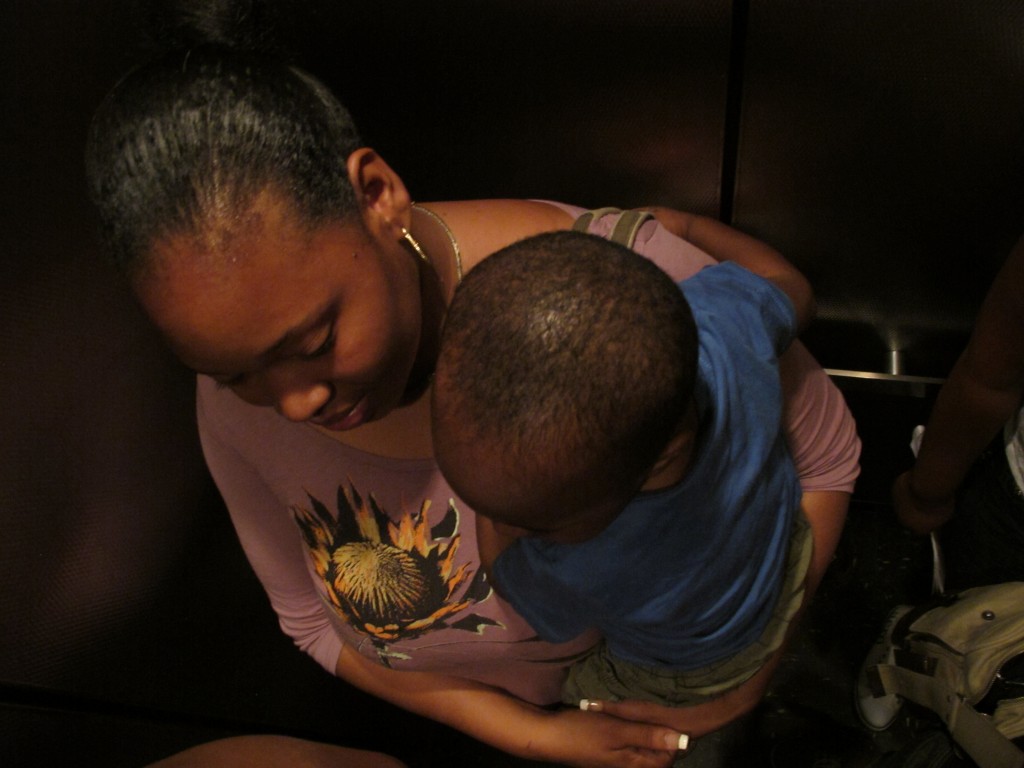
For many New Yorkers, including Cecilia Cudjoe, working full time doesn't pay enough. (Rani Molla/BRONX INK)
Cecilia Cudjoe, or Cici, has traveled more than 10,000 miles in search of a brighter future for herself—and now also for her 6-year-old daughter. In the span of eight years, Cudjoe, 30, has moved from the tropical savanna of her native city of Accra, Ghana, to the colder climate of Stuttgart, Germany, to the the desert in White Sands, N.M., and finally to the Bronx. But while her life has improved, it’s still not as good as she’d want it to be.
“You really need a lot if you want to live comfortably,” she said sitting on a small brown couch amid boxes of possessions in her cramped basement apartment. “It’s not a comfortable life for me.”
Wearing a short-sleeved black blouse that droops at the neck, bright blue pants and crisp tennis sneakers, Cudjoe looks years younger than she does at work, where a bulky white chef’s coat and a black newsboy hat hide her petite figure and soft skin. Her youthful face hides the miles she’s traveled and the challenges she faces every day.
After dropping off her daughter at P.S. 226 in her University Heights neighborhood, the divorced single mother takes a bus and two trains for 45 minutes to reach her job at an upscale Italian restaurant on the Upper West Side. At Salumeria Rosi Parmacotto, she makes $10.50 an hour and works just under 40 hours per week slicing specialty Italian meats that go for $20 a pound. After taxes each week, she brings home approximately $370.
While her wages put her above the federal poverty level for a family of two ($14,710 a year), she makes only half of what the National Center For Children in Poverty, a Columbia University-based policy group geared toward children, considers a living wage for her and her daughter.
Cudjoe is one of 35 million Americans—a quarter of the adult workforce—who work full time but do not make enough money to meet their families’ basic needs, according to Beth Shulman, a fellow at Demos, a public policy organization based in New York City. Situations like Cudjoe’s highlight the difficulties of the working poor in America. They also show the need to change the way poverty is measured.
This month, the Census Bureau announced the creation of a supplemental poverty measure that accounts for the costs of housing, clothes and utilities—a step Mayor Michael Michael Bloomberg’s administration took citywide in 2008.
The supplemental poverty measure raised last year’s national poverty level from 15.2 percent to 16 percent. When the Bloomberg administration switched its method of calculation in 2008, poverty rates in New York went from 19 to 23 percent.
However, these measurements are merely academic: to gauge the effectiveness of anti-poverty efforts. Neither affects the way the federal government disperses money. Washington still disperses aid based on a 1960s calculation in which groceries account for one-third of a family’s income. Monthly grocery costs are then multiplied by three with corrections made for inflation. But food costs are much lower today than they were in the ’60s, while other living costs have skyrocketed.
Nor are the new measurements accurate enough to alleviate the problems of poverty, according to the National Center For Children in Poverty. Jennifer Shaffer, a research analyst at the center, said that both the Census and Bloomberg’s figures “set a much more minimal threshold of poverty-level expenses while NCCP’s Basic Budget sets a higher standard of what a family would need to spend to have a basic and modest standard of living.”
Calculating poverty based on that “basic subsistence level,” Shaffer said, leads to other problems. “The questions we must ask then is what do people sacrifice to make a poverty wage cover the bills? Do they go without health insurance? Live in doubled-up housing? Skimp on meals? Use less or lower-quality child care than they would like to?”
The center estimates that Cudjoe would need to make $46,433 a year to meet her family’s basic needs in the city; Cudjoe’s yearly earnings (before taxes) and child support add up to $31,760.
Cudjoe’s low income has affected every aspect of her and her daughter’s lives, from where they sleep to what they eat. Fortunately Cudjoe is good at getting by on very little.
Cudjoe emigrated from Ghana in 2003, where she left behind a large, tight-knit family.
“When you’re in Africa, you want a better life,” Cudjoe said, in her heavily accented but grammatically perfect English. She’s also fluent in Ga, Akan and Fanti, languages of her homeland. To leave Ghana, she applied for visas in several countries. Only Germany granted her one.
“Whichever visa you get, you go, and you see what happens,” Cudjoe, who completed secondary school in Ghana, said. In Stuttgart, Germany, she worked with her aunt, a tailor at the U.S. Army base there. At the base, Cudjoe met Sara’s father, an American citizen originally from Ghana. Soon after, Cudjoe became pregnant and gave birth to Sara, who was born at the Army hospital and is thus a U.S. citizen. When the U.S. Army relocated Sara’s father to White Sands Missile Range in New Mexico in 2005, he married Cudjoe and applied for a Green Card for her.
Not long after the move, their relationship dissolved and the two separated. Cudjoe found the pace of life too slow and distant in New Mexico, so in 2006 she decided to move to New York where she had a friend. Cudjoe sent Sara to live with her family in Africa for three years to learn about her roots, while she and the friend rented a place together.
For a while, Cudjoe worked in home care but she wanted a job with a more regular schedule when Sara returned to her mother in 2008. The same year, Cudjoe and her husband officially divorced. Last year, Cudjoe found an evening job at Salumeria Rosi. While she didn’t mind the job—Cudjoe said she had never before thought about whether she liked her job, but said, “It’s OK. I like what I do”—she frequently didn’t return home until after Sara was asleep, meaning she couldn’t help Sara with her homework. Cudjoe relies on babysitters and Sara’s aunt to care for her when Cudjoe works.
Since the job was relatively new, Cudjoe was terrified of asking for daytime hours instead of her night shift.
“I prayed that they wouldn’t fire me,” she said. They didn’t, and in fact Cudjoe said her job now gives her preferential hours because she has a daughter.
To get by on what she makes, Cudjoe buys mainly inexpensive staples like rice and beans in bulk quantities. Cudjoe would like to buy more PediaSure for Sara, but says it’s too expensive.
A garden, which she splits with her upstairs neighbor, provides extra produce in the summer. Last season’s tomato and pepper plants stand in place of a front lawn.
The last time Cudjoe went grocery shopping, she spent $400 and estimates that will last them the whole month.
Cudjoe rents her tiny one-bedroom apartment from a family friend for $650 a month, including utilities. She wishes she could give Sara her own room. This winter, she hopes to rent a two-bedroom, $1,200 apartment in Woodlawn with her sister, a home health aide who spends most of her time at the home of her client, a cancer patient. In that way, Cudjoe and her daughter would frequently have their own rooms.
Cudjoe pays $20 a day for an after-school baby-sitter, but the service ends at 6 p.m.; she gets out of work in Manhattan at the same time, so frequently has to pay overtime. She says that sometimes it’s not worth it for her to work full-time because of the high cost of child care. Each month, Cudjoe pays $60 for her phone, $104 for a metro card, $150 for cable and internet, and only $18 for health care through WellCare, a health care plan that provides managed care through Medicaid.
To stretch her budget, Cudjoe must be careful with everything she buys, often forgoing basic items for herself, such as clothing or a separate bed.
“I’m the kind of person that I like everything I have,” Cudjoe said. “I don’t care if If I don’t have something unless I really need it.”
She’s less austere with her daughter. For Christmas, Cudjoe already purchased a large kitchen set that Sara really wanted. She hopes she can buy a LeapPad, a children’s learning tablet, when they go on sale this week. “I don’t mind giving her something I don’t get,” Cudjoe said. “If your child is happy, you’re happy.”
Because of Sara, Cudjoe could work less—20 hours a week—and receive welfare instead of darting back and forth from work to the baby-sitter’s. She would also be eligible for food stamps and daycare through the Human Resources Administration.
But Cudjoe says public assistance would jeopardize her application to become a U.S. citizen, a process she began in October. “People say if you have welfare, they give you a tough time,” Cudjoe said.
While the U.S. Bureau of Citizenship and Immigration Services prohibits those seeking a Green Card from receiving cash assistance, there are no such constraints on those looking to become naturalized citizens, according to Debora Gilmore, director of nonprofit Immigration Advocacy Services in New York. Short-term Medicaid and food stamps, she said, are acceptable in all stages of immigration.
“Naturalization is all based on good moral character,” Gilmore said. “If you’re on public benefits as long as you received them legally and truthfully, you can become a U.S. citizen,” she said, adding that people new to this country can be overly cautious in such matters.
Cudjoe is also hesitant to demand more in child support. She contends she is eligible to receive more than the $500 a month that Sara’s father, who is currently serving the Army in Afghanistan, voluntarily gives her. But she doesn’t want to “put herself through that”—nor does she have the time.
Time, in fact, monopolizes much of Cudjoe’s troubles. “It doesn’t matter the amount of money you have if you’re a single mother,” she said, “You don’t want to miss a young life.”
Because of her job, it’s difficult for Cudjoe to attend parent-teacher conferences and she rarely is able to supervise school trips—a big disappointment to Sara. Sara gets upset that her mother can’t be more a part of her school life. But to support them both, Cudjoe must work full-time. “Sometimes she gets it,” Cudjoe says. “Sometimes she doesn’t. But she’s just a kid.”
Cudjoe describes the instances she had to work but was unable to find a babysitter as the “worst feeling,” recalling a time when this happened to her recently and she was forced to go cry in the bathroom, located through the kitchen.
“I don’t want to lose eight hours and stay home with her,” she said, visibly upset by the prospect. Cudjoe now keeps two babysitters to prevent such a predicament. Regardless, Cudjoe doesn’t feel her current situation is tenable.
Cudjoe has plans to become a registered nurse, but must first take some preliminary courses this spring. She would like to take them at Bronx Community College, but she’d have to bring Sara, so Cudjoe is also weighing the possibility of online classes.
Sara does her part as well.
“It’s not perfect, but she dresses herself,” Cudjoe said, laughing about her daughter’s sartorial choices. “When it’s cold, she wants to wear a skirt,” Cudjoe said. “And she mixes up all the colors.”
But Cudjoe is thankful for her daughter’s help.
Indeed, Cudjoe said her daughter rarely asks for anything, aside from books. Sara is an avid reader and frequently receives perfect scores on her spelling tests. When she grows up, she wants to be a teacher.
“I want her to do better than me,” Cudjoe said. “I don’t want her to be my age working a job like this.”















